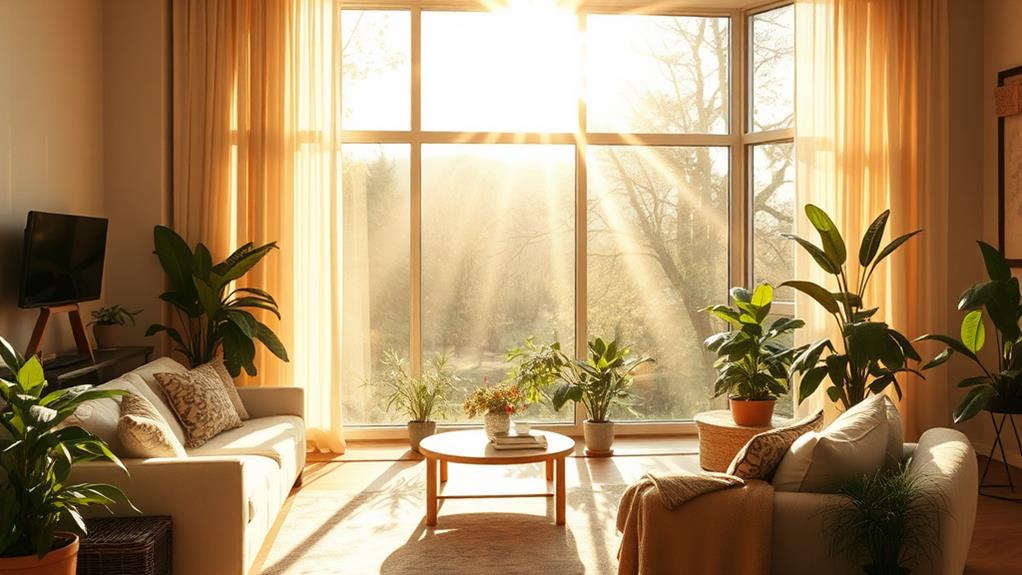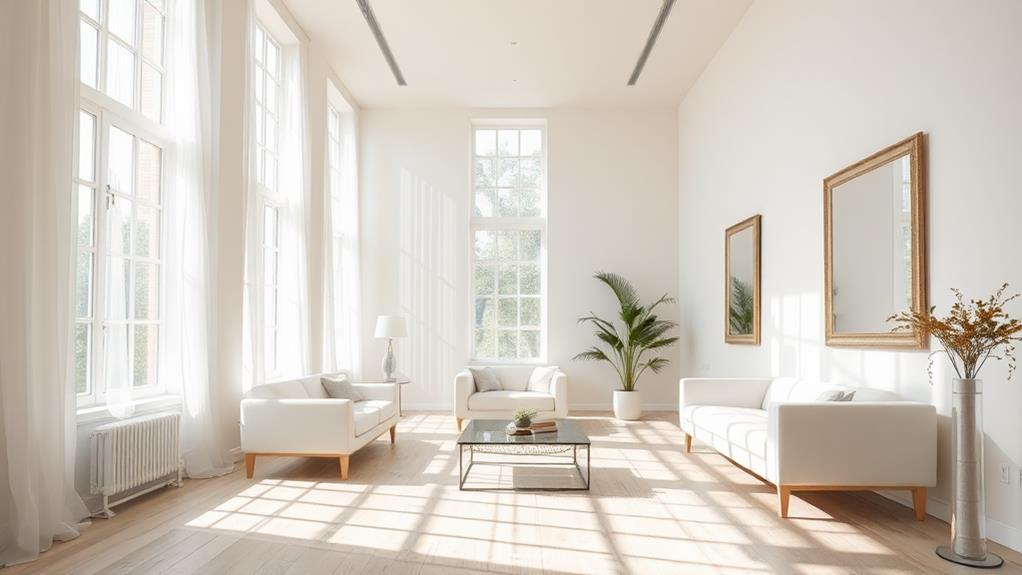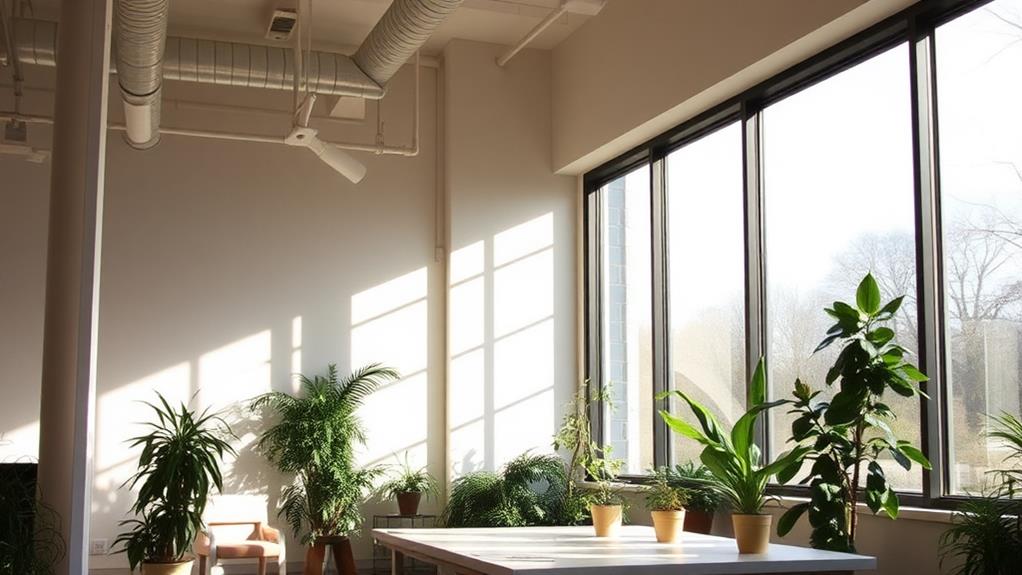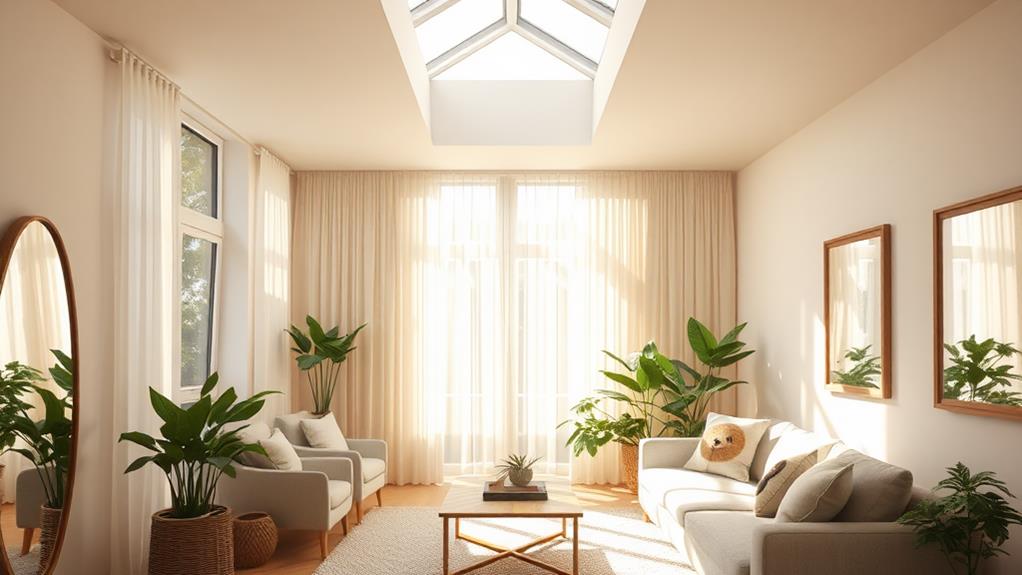To reduce your dependence on artificial light, strategically place windows to maximize natural sunlight. Install skylights or light tubes to bring daylight into interior spaces. Use reflective surfaces and light colors to bounce light around rooms. Incorporate glass doors and partitions to allow light flow between areas. Add light shelves above windows to redirect sunlight deeper into your space. Consider solar tracking mirrors for consistent illumination throughout the day. Design atriums to flood multiple floors with natural light. Implement smart glass technology to control light levels dynamically. Don't forget exterior shading devices to manage glare and heat gain. These strategies can transform your living and working environments while slashing energy costs.
Strategic Window Placement

Windows are the gateway to natural light in any space. To maximize their effectiveness, you'll need to consider several factors when placing them. First, think about the orientation of your building. South-facing windows receive the most direct sunlight throughout the day, making them ideal for main living areas. East-facing windows provide morning light, perfect for bedrooms and kitchens, while west-facing windows offer afternoon and evening light.
Consider the size and height of your windows. Larger windows allow more light to enter, but they can also lead to heat gain or loss. Tall windows let light penetrate deeper into a room. Clerestory windows, placed high on walls, can bring light into the center of a space without compromising privacy.
Don't forget about skylights and light tubes. These can introduce natural light into areas where traditional windows aren't feasible. When planning window placement, also consider the room's function and furniture layout. Avoid placing windows where they'll be blocked by large pieces of furniture. By strategically placing your windows, you'll maximize natural light, reduce your reliance on artificial lighting, and create a more inviting and energy-efficient space.
Skylights and Light Tubes
While strategic window placement is key, there are other innovative ways to bring natural light into your home. Skylights and light tubes offer excellent solutions for spaces where traditional windows aren't feasible or sufficient.
Skylights are windows installed in your roof, allowing sunlight to stream directly into your living space. They're particularly effective in rooms with high ceilings or those on the top floor of your home. You can choose from fixed skylights for constant light or vented options for added ventilation. Modern skylights often come with UV-blocking coatings and rain sensors for automatic closure.
Light tubes, also known as sun tunnels or solar tubes, are a more compact alternative. They consist of a dome on your roof that captures sunlight and a highly reflective tube that channels it into your home. Light tubes are ideal for smaller spaces or rooms where a full skylight isn't practical. They're easier to install than skylights and can fit between roof rafters, making them suitable for hallways, closets, or bathrooms.
Both options can significantly reduce your reliance on artificial lighting during daylight hours, leading to energy savings and a more natural, pleasant indoor environment.
Reflective Surfaces and Colors

Mirrors and glossy surfaces can be powerful allies in your quest for natural illumination. These reflective elements bounce light around a room, effectively amplifying the available sunlight. Position mirrors opposite windows to maximize their impact, creating the illusion of additional light sources. Consider using mirrored furniture or decorative objects to subtly enhance brightness without overwhelming the space.
Light-colored walls and ceilings are crucial for maintaining a bright interior. White, cream, and pale pastels reflect more light than darker hues, making rooms feel airier and more spacious. Don't forget about floors – light-colored tiles, hardwood, or carpets can significantly boost a room's overall brightness.
When selecting furniture and decor, opt for lighter shades and materials with reflective properties. Glass tables, polished metal accents, and glossy finishes on cabinets or countertops can all contribute to a brighter atmosphere. Even fabrics play a role; choose light-colored curtains or blinds that allow filtered sunlight to pass through while maintaining privacy.
Glass Doors and Partitions
Glass doors and partitions offer two key benefits for natural lighting strategies. First, they allow light to flow freely between spaces, maximizing the reach of natural light throughout your interior. Second, they create an open, airy feel that can make rooms appear larger and more inviting.
When incorporating glass doors and partitions, consider using frosted or textured glass for privacy while still allowing light transmission. You can also opt for sliding glass doors to save space and provide flexibility in controlling light flow. For office environments, glass partitions between workstations can help distribute natural light more evenly across the floor plan.
To enhance the effectiveness of glass elements, pair them with light-colored walls and reflective surfaces. This combination will amplify the available natural light and reduce the need for artificial lighting during daylight hours. Don't forget to address glare issues by using Low-E glass or applying window films that reduce heat gain and UV radiation.
Light Shelves

Over time, architects and designers have embraced light shelves as an effective tool for enhancing natural lighting in buildings. These horizontal projections, typically installed above eye level on the interior or exterior of windows, redirect sunlight deeper into a space. By reflecting light onto the ceiling, they create a more even distribution of natural light throughout the room.
You'll find light shelves particularly useful in south-facing windows, where they can capture and diffuse direct sunlight. They're designed to block harsh rays while bouncing softer light further into the interior. This not only reduces glare but also decreases the need for artificial lighting during daylight hours.
When considering light shelves, you'll need to factor in your building's location, climate, and orientation. The shelf's material, angle, and depth all play crucial roles in its effectiveness. You can opt for fixed or adjustable shelves, depending on your specific needs and the changing seasons. Remember, light shelves work best when combined with other daylighting strategies, such as clerestory windows or skylights. They're an excellent way to improve visual comfort, reduce energy costs, and create a more pleasant indoor environment.
Clerestory Windows
Architecture enthusiasts have long recognized the value of clerestory windows in natural lighting design. These high windows, typically placed above eye level, offer a unique solution for bringing daylight deep into a building's interior. You'll find clerestory windows particularly useful in spaces with high ceilings or in areas where privacy is a concern.
When incorporating clerestory windows into your design, consider their orientation. South-facing windows will provide consistent light throughout the day, while east and west-facing ones offer more dramatic lighting effects. To maximize their effectiveness, you'll want to pair them with reflective surfaces that bounce light further into the space.
Don't overlook the potential for natural ventilation that clerestory windows offer. By installing operable units, you can create a stack effect, allowing warm air to escape and promoting air circulation. This dual functionality makes them an excellent choice for sustainable building designs.
Solar Tracking Mirrors
While clerestory windows offer passive lighting solutions, solar tracking mirrors take natural illumination to the next level. These advanced systems use motorized mirrors to actively follow the sun's path throughout the day, redirecting sunlight into your building's interior spaces.
You'll find that solar tracking mirrors can significantly boost the amount of natural light in your rooms, even in areas far from windows. They're particularly effective in deep-plan buildings or spaces with limited exterior wall access. By continuously adjusting their position, these mirrors maximize light capture and distribution, reducing your reliance on artificial lighting.
Installing solar tracking mirrors can lead to substantial energy savings. You'll notice a decrease in your electricity bills as you rely less on artificial lighting during daylight hours. Additionally, these systems can help regulate indoor temperature by controlling the amount of sunlight entering your space, potentially lowering your heating and cooling costs.
When considering solar tracking mirrors, you'll need to factor in initial installation costs and ongoing maintenance. However, the long-term benefits often outweigh these expenses, making them a worthwhile investment for many commercial and residential buildings seeking sustainable lighting solutions.
Atrium Design
Atrium spaces offer a powerful natural lighting solution for multi-story buildings. By incorporating a large, open vertical space with a glass roof or skylights, you can flood multiple floors with natural light. This design strategy not only reduces the need for artificial lighting but also creates an inviting, spacious atmosphere for occupants.
When designing an atrium, consider its orientation to maximize sunlight exposure throughout the day. South-facing atriums typically capture the most light in the Northern Hemisphere. You'll want to balance the amount of glazing with thermal performance to avoid excessive heat gain or loss. Implementing light-diffusing materials or baffles can help distribute daylight evenly and prevent glare.
To enhance the atrium's effectiveness, integrate reflective surfaces on walls and floors to bounce light deeper into the building. You can also incorporate light shelves or clerestory windows to direct sunlight further into adjacent spaces. Don't forget to include operable windows or vents for natural ventilation, which can improve air quality and reduce cooling costs. By carefully planning your atrium design, you'll create a multi-functional space that serves as both a natural lighting solution and a central hub for building occupants.
Smart Glass Technology

Innovation in glass technology has revolutionized natural lighting strategies with the advent of smart glass. This cutting-edge material allows you to control the amount of light and heat entering your space with the touch of a button or automatically through sensors.
Smart glass utilizes electrochromic technology, which changes its tint when an electric current passes through it. You can adjust the glass from clear to various levels of opacity, giving you precise control over natural light throughout the day. This adaptability helps you reduce glare, manage heat gain, and optimize visual comfort without sacrificing views or natural illumination.
You'll find smart glass particularly useful in large windows, skylights, and glass facades. It eliminates the need for traditional window treatments, streamlining your interior design while enhancing energy efficiency. By dynamically responding to changing light conditions, smart glass can significantly reduce your reliance on artificial lighting and HVAC systems.
Additionally, some smart glass products offer UV protection and privacy features, making them versatile solutions for both residential and commercial applications. As you integrate this technology into your building design, you'll create more sustainable, comfortable, and adaptable spaces that harness the power of natural light.
Exterior Shading Devices
For centuries, architects have employed exterior shading devices as a crucial element in natural lighting strategies. These devices help you control sunlight entering your building, reducing glare and heat gain while still allowing natural light to illuminate interior spaces.
You'll find various types of exterior shading devices, including overhangs, louvers, and fins. Overhangs are horizontal projections above windows that block high-angle summer sun but allow low-angle winter sun to enter. Louvers are adjustable horizontal or vertical slats that can be angled to deflect direct sunlight while maintaining views and ventilation. Fins are vertical elements that can be fixed or movable, protecting against low-angle sun from east or west.
When designing your building, consider the climate, orientation, and desired indoor lighting conditions. Properly sized and positioned shading devices can significantly reduce your reliance on artificial lighting and cooling systems. They're particularly effective on south-facing facades in the northern hemisphere, where sun angles change dramatically throughout the year. By integrating these passive solar design elements, you'll create more comfortable, energy-efficient spaces that harness natural light effectively.
Conclusion
You've now explored a wealth of natural lighting strategies. By implementing these techniques, you'll not only reduce your reliance on artificial light but also create spaces that feel more open, vibrant, and connected to the outdoors. Remember, the sun is nature's ultimate light bulb – why not harness its power? As you design or renovate your spaces, let these ideas illuminate your path to a brighter, more sustainable future. The choice is clear: embrace the light!

